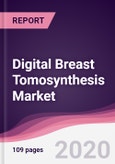Full-filled digital mammography (FFDM) is considered as gold standard in breast cancer screening; but with the introduction of the digital breast tomosynthesis technology, the existing technology is being replaced. The growth of the market is because of the advancements in technology for the detection and diagnosis of cancer and lesions. The digital breast tomosynthesis (DBT) market generated revenue of $1,726m in 2020 and is projected to grow at a double-digit CAGR during the forecast period 2020–2025 to reach $3,591m. The Americas region accounts for the maximum share in the global DBT market, followed by Europe and Asia-Pacific (APAC). The growth of the Digital Breast Tomosynthesis market in APAC is majorly driven by the growing population in major countries such as China and India. During the forecast period 2020–2025, the DBT market in APAC is projected to grow at a CAGR of 16%, while the European DBT market is projected to grow at a CAGR of 13%.
Digital Breast Tomosynthesis Market Outlook
Digital breast tomosynthesis (DBT) is a 3D breast imaging technique that is built on the full-field digital mammography technology. DBT systems create multiple low-dose projection images of a compressed breast from various angles using a rotating X-Ray tube. Images are reconstructed into multiple slices of 1mm thickness and viewed on a monitor approved for tomosynthesis. This minimizes the impact of tissue superimposition and results in improved visualization of the internal structures. Normally, breast screening was performed step by step, starting with full-field digital mammography (FFDM or 2D mammography) followed by digital breast tomosynthesis (3D mammography), or breast Magnetic Resonance Imaging (MRI). FFDM is considered as the gold standard in breast cancer screening. Conversely, with the introduction of DBT technology, it is slowly being replaced. DBT is frequently used as an adjunct technique with FFDM.
Research and studies are being undertaken to consider DBT as a primary screening tool, particularly in patients with dense breasts. 3D mammography has proven to be better than 2D mammography in multiple clinical trials, which has led to an increase in its adoption. Combining 2D and 3D mammography has become the new standard of care since 3D mammography compliments conventional 2D mammography.
This report gives an in-depth analysis of the digital breast tomosynthesis (DBT) market by product, end user, and geography. By product, the DBT market is segmented into Equipment and 3-D Upgradation. By end user segment, the market is bifurcated into hospitals and diagnostic centers.
Digital Breast Tomosynthesis Market Growth Drivers
The major reason for the growth of the market the increase in number of breast cancer cases among women who are involved in the workforce due to prolonged exposure to hazardous agents, such as organic solvents. Owing to increase in the precision and dominance over 2D mammography, the demand for DBT has increased in recent years.
Digital Breast Tomosynthesis Market Challenges
The major constraint while switching to digital technology is the high cost. The 3D system, which tends to be more precise and accurate requires high installation cost, while 2D costs roughly 40% less.
Digital Breast Tomosynthesis Market
Digital Breast Tomosynthesis Market Research Scope
The base year of the study is 2020, with forecast done up to 2025. The study presents a thorough analysis of the competitive landscape, taking into account the market shares of the leading companies. It also provides information on unit shipments. These provide the key market participants with the necessary business intelligence and help them understand the future of the Digital Breast Tomosynthesis market. The assessment includes the forecast, an overview of the competitive structure, the market shares of the competitors, as well as the market trends, market demands, market drivers, market challenges, and product analysis. The market drivers and restraints have been assessed to fathom their impact over the forecast period. This report further identifies the key opportunities for growth while also detailing the key challenges and possible threats. The key areas of focus include the types of products in the digital breast tomosynthesis market, and their different end-users.
Digital Breast Tomosynthesis Market Report: Industry Coverage
- Digital Breast Tomosynthesis Products: DBT Equipment, 3-D Upgradation
- End Users of Digital Breast Tomosynthesis: Hospitals, Diagnostic Centers
The Digital Breast Tomosynthesis market report also analyzes the major geographic regions for the market as well as the major countries for the market in these regions.
The regions and countries covered in the study include:
- North America: The U.S., Canada, Mexico
- South America: Brazil, Venezuela, Argentina, Ecuador, Peru, Colombia, Costa Rica
- Europe: The U.K., Germany, Italy, France, The Netherlands, Belgium, Spain, Denmark
- APAC: China, Japan, Australia, South Korea, India, Taiwan, Malaysia, Hong Kong
- The Middle East and Africa: Israel, South Africa, Saudi Arabia
Digital Breast Tomosynthesis Market Key Players Perspective
Some of the key players mentioned in this report are Hologic Inc., Siemens Healthineers Fujifilm Corporation, GE Healthcare, and Dexela Ltd.
Digital Breast Tomosynthesis Market Trends
- Emerging advanced technology is adding innovative devices for quick diagnosis and detection of cancer and breast lesions.
- The digital breast tomosynthesis market is highly consolidated, wherein, Hologic Inc. is the leading player contributing to nearly 52% of the overall market revenue. The company, being a pioneer in digital breast tomosynthesis, has remained as the dominant player. The other leading players include GE Healthcare, Siemens Healthineers, and Fujifilm Holdings Corporation with a share of 25%, 11%, and 8% respectively. These players hold the major share of the market due to the constant R&D investments and endeavors to build new technologies.
- High cost of DBT devices is the major limiting force for the market growth in Japan, China, India, Brazil, and Rest of the World. The demand for early tomosynthesis screening for breast cancer will continue to witness an upsurge due to a large patient pool in growing economies and high rate of incidences of breast cancer in developed nations/regions such as the U.S. and Western Europe.
Table of Contents
Methodology

LOADING...








